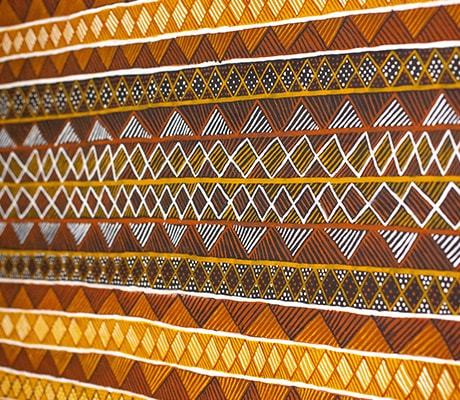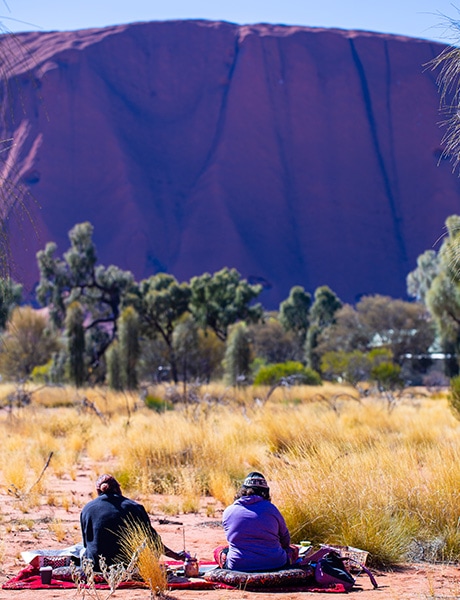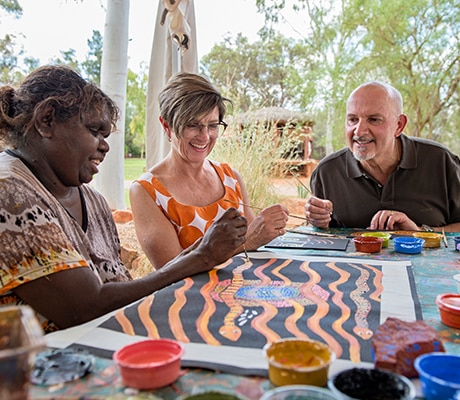October 29, 2020
![]() 6 mins Read
6 mins Read
For an art form with traditions and practices stretching back multiple millennia, the Aboriginal and Torres Strait Islander art movement is having a moment right now in the global market. With dedicated followers such as actor Steve Martin (who famously loaned 10 paintings from his collection to the influential Gagosian Gallery in New York in 2019 as part of its Desert Painters of Australia exhibition) and renowned international museums including London’s Tate Modern adding pieces to its permanent collections, this is a bona fide contemporary art movement steeped in ancient history. But the good news is that investing in it does not require a Hollywood-sized bank balance; in fact, every visitor to the Northern Territory can buy a unique piece of art all their own.

Nomad Art is a gallery specialising in limited edition artworks by artists from Indigenous art centres. (Image: Tourism NT/Nick Pincott)
While Aboriginal and Torres Strait Islander art has been called ‘Australia’s greatest cultural gift to the world’, buying it here in Australia, and specifically on a trip to the Northern Territory, offers an irresistible opportunity to go beyond the mere provenance of a piece. It allows buyers to meet and interact with the artists themselves and experience the country, the colours, the sounds, the mood and the traditions that have influenced and shaped it.

An art form with traditions and practices stretching back multiple millennia. (Image: Tourism NT/Felix Baker)
It is estimated that Aboriginal and Torres Strait Islander art contributes up to $100 million to the Australian economy each year, but on a much more human level, the sale of art through Indigenous owned and operated art centres and any number of art fairs held across the country each year not only provides an invaluable source of income for artists, families and remote communities, but also allows them to take pride in continuing the traditions of the world’s oldest living culture.

Aboriginal and Torres Strait Islander art contributes up to $100 million to the Australian economy each year. (Image: Tourism NT/James Fisher)
With so much significance woven into the act of buying a piece of art, it is important to be respectful of the process, do the research and make informed decisions in order to end up with a work that is both authentic and ethical, and that you can also take pride in owning.

Buying in Australia allows buyers to meet and interact with the artists themselves. (Image: Tourism NT/Shaana McNaught)
While most people considering buying a piece of Aboriginal or Torres Strait Islander art to commemorate a trip to the Northern Territory will imagine themselves returning with a painting, there are myriad styles and mediums to choose from: mesmerising contemporary dot paintings on canvas, traditional bark paintings, sculpture, woven fibre art, digeridoos, works on paper, prints and cultural regalia.
Decide the style you are interested in and seek out artists and community art centres in regions and locations that specialise in them, from the ochre paintings on bark that are typical of Arnhem Land to the intricate woven fibre art produced by the female Tjanpi artists of the remote Central and Western desert regions (Tjanpi Desert Weavers, a social enterprise of the Ngaanyatjarra Pitjantjatjara Yankunyytjatjara [NPY] Women’s Council, also has a public gallery in Alice Springs).

There are myriad styles and mediums to choose from. (Image: Tourism NT/Felix Baker)
Buying art in an ethical way means you are contributing to the sustainability of Aboriginal art into the future and showing respect for the artists themselves and the rich history that influences their work. According to the Indigenous Art Code, developed to establish a set of standards between dealers and artists to ensure fair and ethical trade in artwork, buyers should not be afraid to be inquisitive, whether buying from a gallery, at auction or at an art fair; the three questions you should be asking when making a purchase are: ‘Who is the artist?”; ‘Where are they from?’ And ‘How are they paid?’

Be inquisitive, whether buying from a gallery, at auction or at an art fair. (Image: Tourism NT/Felix Baker)
It is also important to establish provenance, a record of ownership that confirms that an artwork is authentic and has been traded in an ethical way, including fair payment for the artist. The Indigenous Art Code advises that any piece of Aboriginal or Torres Strait Islander art bought for more than $250 at an art centre should come with an authentication certificate; you should always ask for one if it is not offered.

Buying art in an ethical way means you are contributing to the sustainability of Aboriginal art. (Image: Tourism NT/Felix Baker)
While it is possible to buy Aboriginal art from dealers, the most ethical way to purchase is from Indigenous-owned and operated art centres, including the likes of Injalak Arts in Gunbalanya, Jilamara Arts and Crafts Association on Melville Island, Karungkarni Art and Culture in Katherine and Aaruku Arts in Uluru, owned and operated by Anangu of the Central and Western Desert. Non-profit cooperatives run by artists and communities, in addition to offering direct access to the artists, offering the chance to see first-hand how artworks are made and the inspiration behind them, these community art centres allow you to be confident the art you are buying is authentic and that the artists benefiting from all sales.

Contemporary Aboriginal art for sale at Jilamara Arts and Craft Association. (Image: Tourism NT/Felix Baker)
Art fairs are another great way to buy Aboriginal art straight from the source. There are a number of fairs held each year in the Northern Territory including Desert Mob in Alice Springs, presented by Araluen Arts Centre and Desart and representing Aboriginal arts and crafts centres of the Central Desert, and the Darwin Aboriginal Art Fair (DAAF). Staged by the not-for-profit Darwin Aboriginal Art Fair Foundation, DAAF does not attach commission to works sold, which means 100 per cent of the money made (some $11.6 million in the last five years) goes directly to the artists and their communities.

The most ethical way to purchase is from Indigenous-owned and operated art centres. (Image: Tourism NT/Shaana McNaught)
In the homogenised, mass-produced world in which we live, being able to source artworks directly from the artists producing them and gaining insight into the creative process is not just unusual, it’s a privilege. Going straight to the source to buy Aboriginal art when visiting the Northern Territory, interacting with the artists and hearing their stories, is as much an experience as seeing Uluru or exploring Kakadu. Take the time, make the effort and you will be richly rewarded.

Interacting with the artists and hearing their stories, is as much an experience as seeing Uluru. (Image: Tourism NT/Shaana McNaught)
For the  best travel inspiration delivered straight to your door.
best travel inspiration delivered straight to your door.
LEAVE YOUR COMMENT